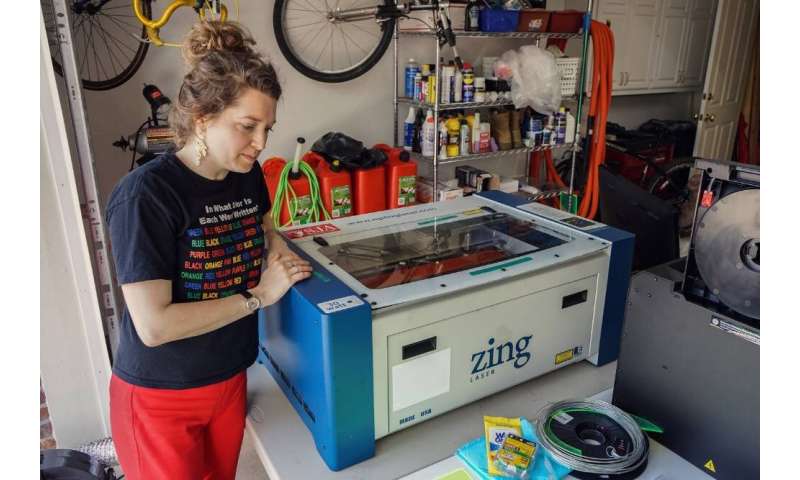
LSU Biomedical Engineering senior Meagan Moore is never one to back down from a challenge, especially if it means helping others (she created a cancer model to help personalize treatment last year). So, why would the coronavirus pandemic be any different?
Working alongside LSU Medical Physics and Health Physics Director Wayne Newhauser, emergency room physician Tom Fox, two LSU physics students, and members of the community, Moore is once again helping those in need by creating face masks, ventilators, and face shields for nurses and doctors working with COVID-19 patients at LSU Health in New Orleans.
Before Moore got the call to help create a ventilator prototype less than a week ago, she and her mother, Kathryn Moore, were knee deep in looking at patterns and sewing face masks for the nurses and doctors in New Orleans who are treating patients with COVID-19, the disease caused by the coronavirus. Moore and Kathryn, who has two degrees in the fashion and textile merchandise field, followed a mask pattern they found online that was designed by a hospital chain. They, along with other experienced seamstresses, found the pattern difficult to follow, so they improvised.
Their mask consists of two layers of tightly woven cotton sewn together with elastic bands that go over the ears. Once elastic became hard to come by, Kathryn got creative and used elastic bands from old Mardi Gras ball masks.
“Ideally, the mask is going over an N-95 mask to provide additional protection so the N-95 can continue being used,” Moore said. “Our masks can be sterilized appropriately at the hospitals because most people aren’t going to use or don’t have the level of disinfectant needed at their house.”
So far, Kathryn has sewn more than 130 masks, with each one taking 30 to 45 minutes to sew.
“My mom has been very meticulous with the details,” Moore said, to ensure they are effective and comfortable. Each mask is individually packaged and were delivered to Ochsner Hospital in Kenner on Saturday.
In the midst of her mask endeavor, Moore received a call from Newhauser asking if she could help him create a ventilator part for COVID-19 patients in New Orleans. Seeing the dire need for more ventilators should the number of COVID-19 cases continue to increase, Moore said yes without hesitation.
Moore and Newhauser, who is also a professor in LSU’s Department of Physics & Astronomy, are working directly with local respiratory specialists, medical physicists, and engineers to fabricate ventilator parts and a variety of personal protective equipment for healthcare personnel in Louisiana.
“We’re doing a lot of telecommunicating with doctors,” Moore said. “We’re currently doing 3-D prints with base stock because the hospitals have gotten to the point where they are desperate and we’re trying to push things through. Certain companies have done copper printing but it’s extremely slow and expensive. Our 3-D-printer material is PLA (polylactic acid) but we could possibly move up to another type of material.”
An LSU resident emergency room physician picked up prototype ventilator pieces from the LSU team on Saturday for inspection and evaluation. LSU Physics student Maxwell Cole and LSU Renewable Natural Resources alumna Cathlin Disotell are assisting Newhauser and Moore; all are working in Newhauser’s garage while practicing social distancing.
“We’ve contacted multiple filter companies to ask questions like, ‘Where can we get this filter right now?,'” Moore said, “and realize, ‘Oh, it’s made in China.’ One thing I read is that one single country cannot produce a ventilator on its own. All of the different parts come from different countries. That was eye-opening. We’re seeing a stopgap like never before. You don’t have time to do full-on testing and hit it with everything a lab could do.”
While the team is working on prototyping ventilator parts, it is also prototyping field-expedient face shields with help from LSU Chemical Engineering Research Specialist Nick Lombardo.
“I was using a laser cutter to make an acrylic template for people to make their own face shield using cardboard that would go on their head and a clear plastic document protector to staple onto it to protect against initial droplet exposure,” Moore said.
A local surgeon, Dr. John Faust of Baton Rouge Orthopedic Clinic and Our Lady of the Lake Children’s Hospital, is assisting the team in prototyping protective gowns, which are in short supply. The LSU COVID-19 response team is exploring production and other business logistics, including collaboration with local industry and possible public private partnerships.
“Our goal for today is to figure out how to make gowns of reasonable quality from materials and tools that are readily available,” Newhauser said. “Soon, we will hand off to other teams to scale up training of workers and production of the gown.”
Additionally, the team is coordinating with LSU personnel on the COVID response to explore scaling of the instruction and materials to create a community effort.
Though the team has not yet been asked to create a ventilator splitter, which would allow more than one patient to use a ventilator at the same time, Moore has unsurprisingly started creating one because, “it seems like that’s the direction things are going to go,” she said.
Though being under quarantine may cause many people boredom and stress, Moore seizes every free moment of it to make a difference.
“I really don’t get exhausted from doing this kind of stuff,” she said. “It can wear a lot of people down. I like helping people and this is unlike any other scale of being able to help, other than [Hurricane] Katrina, which was the most horrible thing I can think of. I’m happy to show up and throw whatever I have at it. We have a lot of brilliant people on our project and we’re really fortunate to have the opportunity to help others.”
“In the war on COVID-19, our modern-day equivalent of Rosie the Riveter is ‘Meagan the Maker,'” Newhauser said. “She exemplifies the spirit and engagement of LSU’s students.”
Source: Read Full Article
